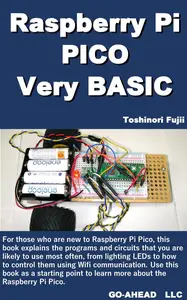
Free Download Raspberry Pi PICO Very BASIC(Paperback black-and-white edition) by Toshinori Fujii
English | May 17, 2024 | ISBN: N/A | ASIN: B0D387YQZJ | EPUB | 11 Mb
This is the paperback black-and-white edition (paper: white) of Raspberry Pi Pico Very Basics.
Please note that this is the same content as "Raspberry Pi Pico Very Basic".
1.Introduction
When it comes to microcontrollers, Arduino UNO, Raspberry Pi and MicroBit are used. The MicroBit is probably the least demanding of these, as the software to be written to the MicroBit microcontroller can be written in three main ways, or in blocks as in Scratch. Another commonly used microcontroller is the Arduino UNO from the Arduino series. This microcontroller is similarly available with the Arduino IDE C software, which can be downloaded free of charge. As these microcontrollers are widely used by many people, a lot of information is available on the web and this information makes them much easier to use.
Now, the Raspberry Pi is a bit harder than these two microcontrollers. The Raspberry Pi is more like a Linux PC than a microcontroller. The Raspberry Pi is now available in 5, which is equivalent to the more powerful Windows PCs of a decade ago.
The Raspberry Pi Pico described in this manual, unlike the Raspberry Pi, is not a PC, but is treated like an Arduino or MicroBit microcontroller: you write the program on the PC and write the program from the PC to the microcontroller. Writing can be done via USB, so it is easy to operate. The Raspberry Pi Pico W is also Wifi enabled. This allows you to study the IoT. It is also relatively cheap compared to other Raspberry Pi's, around 10$, and if it breaks, it is less of a shock.
This book explains the programs and circuits that you are likely to use most often, from lighting LEDs to controlling the Raspberry Pi Pico using Wifi communication, for those who are new to the Raspberry Pi Pico. Use this book as a starting point to learn more about the Raspberry Pi Pico.
Table of Contents
1.Introduction
2.Raspberry Pi
2.1 Raspberry Pi Pico W
2.2 Installing Thonny
2.3 Writing the firmware
2.4 Writing programmes
3.Raspberry Pi
3.1 Displaying "Hello World"
3.2 Display of four arithmetic operations
3.3 Calculate and display variables
3.4 Like the increment operator
3.5 Bitwise operators
3.6 Binary, octal and hexadecimal numbers
3.7 Calculation of real numbers
3.8 Adding a comment
3.9 Branching and repetition
3.10 Iteration
3.11 Arrays
3.12 Input/output to/from files
3.13 Character strings
3.14 Functions
4.Elements for the experiment
(1)LED
(2)Resistance (1/4W)
(3)Breadboard
(4)Jumper wire
(5)Piezoelectric speaker
(6)Servo motor
(7)Variable resistors
(8)CDS cell
(9)Full-colour LEDs
4. Experiments with RaspberryPico
4.1 Experiments with lighting LEDs
4.2 Switch experiment
4.3 Experiments with Speakers
4.4 Servo motor experiments
4.5 Communication experiment
4.6 Sensor experiment
5. Fabrication of autonomous mobile robots
6. Communication over Wifi
(1) Check MAC address
(2) Connecting to a wireless LAN
(3) LED on wireless LAN, ON/OFF
(4) Robot control via wireless LAN
References
